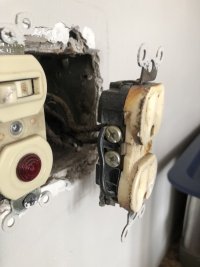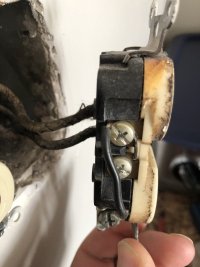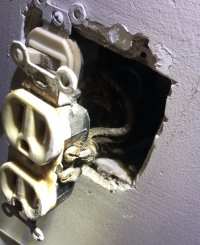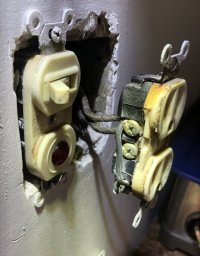xanadu245
New Member
Starting with A little history to help fill in a few details. The house was built in 1956 and a fair bit of the wiring is likely still original which was MC cable with a hot and neutral which had the plastic/rubber coating and a fabric sheath (kind of hard to tell which was black and which was white as both looked black with one being just a little lighter).
I went to replace a receptacle as the plastic at the bottom was breaking as it seemed to be old and brittle. I thought it would be a simple replacement that I've done lots of times. I used a "circuit detective" to figure out what breaker it was and shut off that breaker in preparation for the swap. It was a 20amp single pole breaker. When I got the cover off and started removing the receptacle, I found it was 15amp. OK, I have several options handy with a regular 15 or 20 amp receptacle as well as a 20amp GFCI receptacle to replace it with, so not a major issue. It's in a 2-gang metal box with a duplex receptacle on one side and light switch with indicator light for the basement lite on the other side. After turning off the breaker, I found that the light switch is still live.
Here's where the "Unusual wiring" comes in. When I got the receptacle out, being that the MC Cable didn't have a 3rd ground conductor like more modern MC and Romex cable), I initially figured that someone had just replaced a 2 prong receptacle with a 3 prong and didn't connect a ground, which I don't like to see, but have seen done. When I got it further out and twisted it around more to get a better look, I found that both of the wires (black and lighter black (see note at the beginning)) were connected to the brass screws and nothing appeared to be connected to the silver screws. I also found that someone had put a small piece of wire from the ground screw to one of the silver screws. I've never seen anything like that before. With the 2 wires disconnected from the old receptacle and separated, I turned the breaker back on temporarily to test the wires with a multimeter. As the box was bonded, I tested from each wire to the box and found that both were showing about 90-100v. Not entirely unexpected with the lower voltage as the MC cable isn't a true ground, but I had expected only one of them to be hot, not both. Before starting the whole process, I had also tested with a plug in tester to see if it showed an open neutral or any other issues and it showed "correct". It had also tested at 118v between neutral and hot with the multimeter. As the only things that have been plugged into this receptacle were a nightlight and occasionally a crock-pot (both 2 prong), I was just going to put in the GFCI receptacle, label it as "No Equipment Ground", and call it a day, but having both wires connected to the brass screws and nothing but a short jumper wire from the silver screw to the ground screw threw me off and had me concerned. It's definitely not a 240v receptacle. I've attached some pics to help, hopefully. I'm not an electrician, but I have done quite a bit of wiring for outlets and lighting to add new circuits or make repairs. I could have just duplicated what was already there with a new outlet, but doesn't seem right, even though that's how it was when we bought the house and it's been fine for 2+ years. Sorry if this is a bit of a head scratcher.
I went to replace a receptacle as the plastic at the bottom was breaking as it seemed to be old and brittle. I thought it would be a simple replacement that I've done lots of times. I used a "circuit detective" to figure out what breaker it was and shut off that breaker in preparation for the swap. It was a 20amp single pole breaker. When I got the cover off and started removing the receptacle, I found it was 15amp. OK, I have several options handy with a regular 15 or 20 amp receptacle as well as a 20amp GFCI receptacle to replace it with, so not a major issue. It's in a 2-gang metal box with a duplex receptacle on one side and light switch with indicator light for the basement lite on the other side. After turning off the breaker, I found that the light switch is still live.
Here's where the "Unusual wiring" comes in. When I got the receptacle out, being that the MC Cable didn't have a 3rd ground conductor like more modern MC and Romex cable), I initially figured that someone had just replaced a 2 prong receptacle with a 3 prong and didn't connect a ground, which I don't like to see, but have seen done. When I got it further out and twisted it around more to get a better look, I found that both of the wires (black and lighter black (see note at the beginning)) were connected to the brass screws and nothing appeared to be connected to the silver screws. I also found that someone had put a small piece of wire from the ground screw to one of the silver screws. I've never seen anything like that before. With the 2 wires disconnected from the old receptacle and separated, I turned the breaker back on temporarily to test the wires with a multimeter. As the box was bonded, I tested from each wire to the box and found that both were showing about 90-100v. Not entirely unexpected with the lower voltage as the MC cable isn't a true ground, but I had expected only one of them to be hot, not both. Before starting the whole process, I had also tested with a plug in tester to see if it showed an open neutral or any other issues and it showed "correct". It had also tested at 118v between neutral and hot with the multimeter. As the only things that have been plugged into this receptacle were a nightlight and occasionally a crock-pot (both 2 prong), I was just going to put in the GFCI receptacle, label it as "No Equipment Ground", and call it a day, but having both wires connected to the brass screws and nothing but a short jumper wire from the silver screw to the ground screw threw me off and had me concerned. It's definitely not a 240v receptacle. I've attached some pics to help, hopefully. I'm not an electrician, but I have done quite a bit of wiring for outlets and lighting to add new circuits or make repairs. I could have just duplicated what was already there with a new outlet, but doesn't seem right, even though that's how it was when we bought the house and it's been fine for 2+ years. Sorry if this is a bit of a head scratcher.




